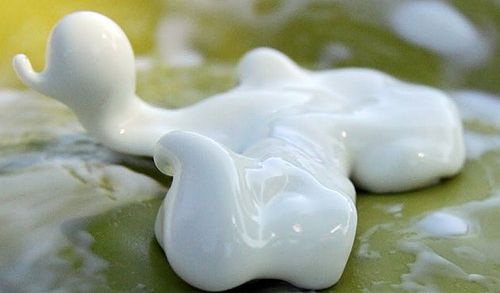Non-Newtonian Fluids
Claimed by Kyle Sabell
A non-Newtonian fluid is a specific type of fluid which does not behave in the same manner as regular fluids. The most notable difference in non-Newtonian fluids is that their viscosity is dependent on the shear rate, or the rate that shearing deformation is applied. In a Newtonian fluid, the relationship between the shear rate and force applied can be modeled by a linear curve. Non-Newtonian fluids exhibit a behavior which lacks a straight-line relationship between the shear rate and force applied, meaning that the viscosity of the fluid changes when a force is applied. This is noted by the strange "dancing" movements provided by the fluid whenever it is vibrated. Another way of looking at this can be that for normal liquids, the resisting force will increase proportionally with the force applied. With a non-Newtonian fluid, however, the resisting force will NOT act proportionally to the force. For example, if you were to double the force on ketchup, a non-Newtonian fluid, the resisting force would actually decrease in half.


Significance
Applications
Non-Newtonian fluids have a variety of real-world applications. It has been found that they provide an excellent remedy to potholes, since the stress provided by fast-moving cars would drastically increase the viscosity of the dried fluid, providing a stable driving surface. These fluids also have a place in body armor, specifically bullet-proof vests. In industry, non-Newtonian fluids are often used in hydraulic systems because of they become thicker when a larger force is applied. Recent uses for these fluids have included installment into sneakers. When the user is standing still, the liquid flows to the shape of the foot, but when the user is running, the fluid would become more solid, protecting the foot from injury.
A Mathematical Model
The basic behavior of a non-Newtonian fluid can be described with the following equation:
History
Non-Newtonian, as well as Newtonian, fluids were first described by scientist Isaac Newton during the 1600s. The idea came when Newton wanted to know how much force had to be applied to a liquid for the liquid to reach a desired flow. Upon working with many different types of fluids, Newton came to the conclusion that some liquids behaved in a very similar manner(Newtonian fluids), while others behaved in a very extraordinary and different manner(non-Newtonian fluids).
Examples of Non-Newtonian Fluids
- Ketchup
- Toothpaste
- Starch mixed with water
- Shampoo
- Blood
- Custard
- Paint
See also
Further reading
- Tropea, Cameron; Yarin, Alexander L.; Foss, John F. (2007). Springer handbook of experimental fluid mechanics.
- Chhabra, R.P. (2006). Bubbles, Drops, and Particles In Non-Newtonian Fluids. (2nd ed.). Hoboken: Taylor & Francis Ltd.
- Fridtjov Irgens(2014). Rheology and Non-Newtonian Fluids.
External links
References
- Tropea, Cameron; Yarin, Alexander L.; Foss, John F. (2007). Springer handbook of experimental fluid mechanics.
- Chhabra, R.P. (2006). Bubbles, Drops, and Particles In Non-Newtonian Fluids. (2nd ed.). Hoboken: Taylor & Francis Ltd.
- Fridtjov Irgens(2014). Rheology and Non-Newtonian Fluids.
- "What Is a Non-Newtonian Fluid?" General Chemistry Online: FAQ: Liquids:. N.p., n.d. Web. 03 Dec. 2015.
